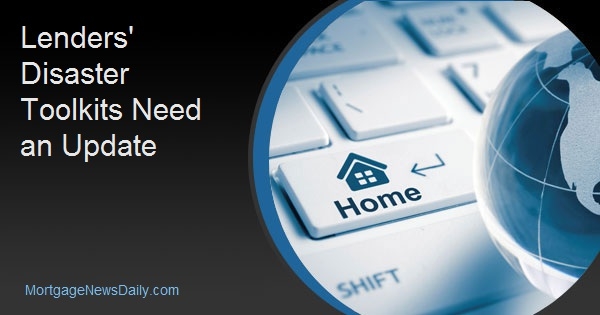The costs of the recent hurricanes that struck in August and September are coming home to roost. The first two in the recent rolling series are, in fact are largely blamed for the first job loss in 80 months, a 33,000 deficit in September. Last week we reported a Black Knight Financial Services' estimate that lenders had $705 billion in unpaid principal balances exposed to risk from Hurricanes Harvey and Irma which caused massive destruction in Texas (and to a lesser extent Louisiana) and Florida (and Georgia) respectively. Not yet plugged into the accounting is the near total devastation in Puerto Rico and the U.S. Virgin Island from Irma and Maria and the still unfolding story of damage from Hurricane Nathan that came ashore last weekend.
The Urban Institute (UI), in an article in its Urban Wire blog, says it is time lenders and other stakeholders "enhance their existing toolkit" to help homeowners cope with the increasing numbers and severity of such disasters. They point out that the cost will eventually be borne by more than just the homeowners, lenders, and other stakeholders initially and directly affected.
As the destruction from the first two storms came into focus, "Mortgage market stakeholders-regulators, housing agencies, servicers, consumer advocates, and nonprofits- offered immediate assistance to affected households," the paper's authors, Karan Kaul and Laurie Goodman, say. Fannie Mae, Freddie Mac, and the Federal Housing Administration (FHA) announced an automatic 90-day forbearance (with possible extensions) for affected borrowers and temporary moratoria on foreclosures and evictions to give affected families time to gather and rebuild. The agencies have also instructed mortgage servicers to waive late fees associated with delayed payments and suspend credit bureau reporting for the time being.
While this will help, UI says, there are limits to forbearance (temporary payment relief) and loan modification (permanent reduction in monthly payment) as disaster recovery tools. Forbearance tends to be most effective during financial disruptions such as job loss or a temporary increase in expenses. If a borrower can defer a few monthly payments it gives some breathing room, enabling them to stabilize their financial situation.
Recovery from a Hurricane, tornado, or wildfire however can be a long-term affair. Borrowers need to assess the extent of damage, sort out insurance coverage, file a claim, wait for approval, and then schedule repairs and rebuilding at a time when materials and labor are probably stretched thin. While dealing with the physical damage, homeowners must keep their household safe and sheltered as well. UI says temporary forbearance is unlikely to help many in this position.
Borrowers may be able to follow up the forbearance period with a loan modification, but any reduction in the monthly payment is likely to be offset by the cost of rebuilding which is likely to be higher than normal and take longer.
Solutions are further affected by the recent rise in mortgage rates. Following the financial disaster of 2008, loan modifications provided significant payment relief to delinquent borrowers because interest rates were falling. Most borrowers today already hold very low-rate mortgages so rate reductions won't help much to reduce monthly payments. Instead, modifications will be heavily reliant on capitalization and term extensions. While still useful in achieving payment reduction, additional accrued interest makes them expensive over time, and they may not provide a sustainable reduction in monthly expenses for those with substantial damage.
Many borrowers, hit with the double financial burden of resuming monthly mortgage payments while assembling funds for repair may choose to abandon their damaged or destroyed homes. Those with small amounts of equity or inadequate insurance coverage are at higher risk of doing so.
Fannie Mae and Freddie Mac (the GSEs) have a loan modification toolkit that is more flexible and easier for both borrowers and servicers to use than are those from FHA, the VA, or private lenders. Accordingly, their borrowers could receive better and faster assistance than others, even if the damaged homes are next to each other. Perhaps as policy makers see this disparity in action they will see the importance of working toward a more efficient loss mitigation toolkit, one where assistance is based on borrower and property circumstances as opposed to who owns the mortgage.
What is needed, UI says is an efficient market for rehabilitation financing. FHA currently offers lending products geared toward repair and reconstruction, and the GSEs have home renovation products. Borrowers are largely unaware of these programs and underwriting them requires specialized skills such as monitoring and documenting the repairs which many lenders don't have in-house. They also carry elevated repurchase risk.
Under current disaster guidelines, servicers are not instructed to evaluate borrower eligibility for rehabilitation financing when modifying a loan, even though efficient access to such financing might lead borrowers to rethink abandoning their homes. A pilot program that requires servicers to educate and evaluate borrowers for rehabilitation financing options and makes this financing easier to access is worth considering.
UI says the eventual housing costs related to hurricanes will spread beyond the areas where they occur. "Every damaging storm that strikes takes us one step closer to a world where this cost will begin to get priced in, through higher mortgage rates, higher insurance premiums, and possibly curtailment of credit in coastal communities. The mortgage ecosystem, together with policymakers, will have to figure out how to work through these issues."







